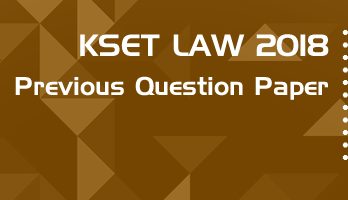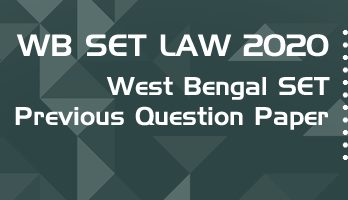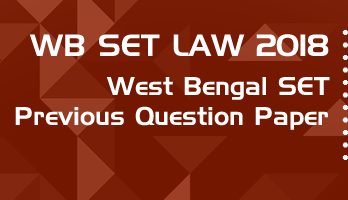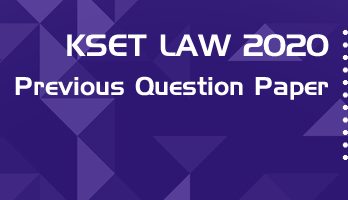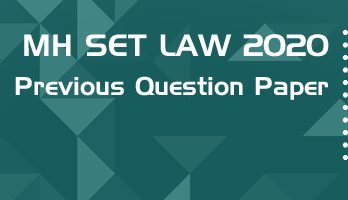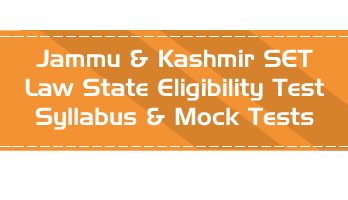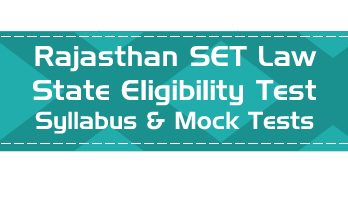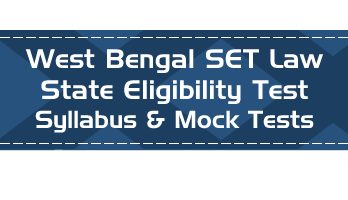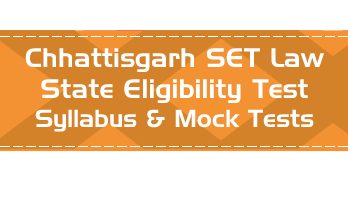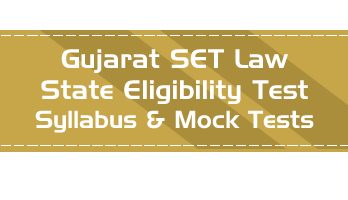- Based on latest Telangana State Eligibility Test Law Paper II Syllabus
- Law Subjects Overview Material covering important topics and concepts - 650 page PDF Book
- 50 Full Length Mock Tests - New Pattern Paper II, with 100 questions each
- 50 Mini Practice Mock tests - with 25 questions each
- Unlimited Practice - New Questions in every mock test with every attempt
- Answer choices of all questions shuffled randomly for better practice
- Database of over 9500 MCQs covering the entire syllabus
- Includes new comprehension based questions
- Questions & Answer Choices randomly shuffled in every attempt for better practice
- Accessible 24 x 7 via Smart-Phone browsers and Desktops
"Just wanted to let you know that I have cleared JRF with 99.99th percentile. Thank you for all your help and support that made it possible. " - Kanchan Yadav
"Thank you so much for the UGC NET test series. I finally qualified the exam. It was possible because of the mock test series provided by your team." - Robin Jaiswal
This previous question paper is Law Paper III from the TS SET 2012 – Telangana State Eligibility Test that was conducted in 2012.
The pattern of the TS SET Law has been changed from 2018 onward, where the previous paper III has been removed and the scope of Paper II has been increased from 50 questions to 100 questions. Which means that the current paper II will have questions from the complete syllabus.
Note : The syllabus for the UGC NET papers 1 & 2 has been changed since Jan 2019; so the syllabus for this exam is also expect to change.
The questions from this paper are included in the database for the LawMint.com – TS SET Law Online Practice pack.
Check out the latest official syllabus of the TS SET Law in this article : TS SET Law Syllabus and Details.
TS SET Law Previous Question Paper III 2012
1. The Supreme Court does not have original jurisdiction regarding a dispute between
(A) The Government of India and a State or States
(B) The Government of India and one State on one side and one or more States on the other side
(C) Two States
(D) A citizen and a State
2. Which one of the following is not an automatic consequence of the proclamation of emergency ?
(A) Suspension of the enforcement of fundamental rights except those conferred by article 20 and 21
(B) Extension of the union’s executive power to the issue of directions to any State as to the manner in which its executive power has to be exercised
(C) Extension of the power of Parliament to the making of legislation in regard to items of the State list
(D) Suspension of Article 19
3. The statutes ‘The Scheduled Castes and Scheduled Tribes (Prevention of Atrocities) Act 1989’ and ‘Protection of Civil Rights Act 1956’ are based on
(A) Article 14
(B) Article 15
(C) Article 16
(D) Article 17
4. Under the Indian Constitution which one of the following is not a specific ground on which the State can place restrictions on freedom of religion ?
(A) public order
(B) morality
(C) social justice
(D) health
5. Arrange the following decisions of the Supreme Court on Fundamental Rights relating to personal liberty in the correct chronological sequence.
(1) Maneka Gandhi V. Union of India
(2) A.D.M. Jabalpur V. Shivakanth Shukla
(3) A.K. Gopalan V. State of Madras
Select the correct answer using the codes given below
Codes :
(A) 3, 2, 1
(B) 2, 1, 3
(C) 2, 3, 1
(D) 1, 2, 3
6. In the event of occurrence of vacancies in the offices of both, the President and the Vice President of India, who among the following shall discharge functions of the President till a new President is elected ?
(A) Speaker of Lok Sabha
(B) Leader of the majority party in the Lok Sabha
(C) Chief Justice of India
(D) Senior most Governor
7. Which of the following Amendments inserted the words “Nothing in Article 13 shall apply to any amendments made under this Article” in Article 368 ?
(A) Forty-Second Amendment Act
(B) Forty-Fourth Amendment Act
(C) Twenty-Fourth Amendment Act
(D) Twenty-Second Amendment Act
8. Which of the following is correctly matched ?
(A) Republic : head of the State is hereditary monarch
(B) Sovereign : Constitution rests on the people’s will
(C) Democratic : Constitution does not recognise legal supremacy of another country
(D) Secular : State is without any religion of its own
9. Which one of the following is not part of the principle of proportionality ?
(A) The court considers what is necessary to achieve the legitimate aims of a particular policy or legislation
(B) Proportionality often involves striking a balance between the benefits to be achieved by doing something and the harm that may be done by interfering with a person’s convention rights in the process
(C) The court looks at (1) the comparative importance of the actual rights being claimed in the individual case; (2) the justifications for interfering with or restricting each of those rights ; and (3) apply the proportionality test to each
(D) Proportionality has now replaced unreasonableness as a ground for judicial review
10. Which one of the following is not a key feature of the separation of powers ?
(A) The same persons should not form part of more than one of the three organs of government
(B) One organ of government should not control or interfere with the work of another
(C) Everyone is equally subject to the law
(D) One organ of government should not exercise the functions of another
11. Which one of the following statements is false in respect of subjective discretionary powers ?
(A) In carrying out its functions, the Judiciary gives Parliament and the executive no latitude whatsoever where national security is concerned
(B) Indefinite imprisonment without charge is contrary to the rule of law because it deprives the detained person of the protection given to them by the process of criminal trial
(C) The primary burden of protecting national security rests with the executive
(D) The role of the judiciary, in a legal system based on the rule of law, is to make sure that legislation and ministerial decisions do not overlook the human rights of those adversely affected and that both Parliament and the executive give due weight to fundamental rights and freedoms
12. Which one of the following statements is true ?
(A) The decision in Anisminic Ltd. V Foreign Compensation Commission (1969) rendered obsolete the distinction between errors of law on the face of the record and other errors of law by extending the doctrine of ultra vires
(B) Anisminic gives the High Court jurisdiction to review a tribunal’s decision on its merits
(C) After Anisminic a non jurisdictional error cannot be challenged on appeal
(D) After Anisminic jurisdictional errors can be challenged in the country Court
13. Which one of following statements is false ?
(A) A Quashing order, Mandatory order, or Prohibiting order must be claimed by judicial review
(B) An injunction or declaration may be claimed by judicial review
(C) All judicial review remedies are mandatory
(D) A claim for judicial review may include a claim for damages, restitution or the recovery of a sum due but a claimant may not seek such a remedy alone
14. Which one of the following statements is true ?
(A) Judicial review focuses on the way public bodies make their decisions. The basis of a judicial review claim is not that a decision is wrong, unless the decision is so wrong that no reasonable public body could have reached it
(B) In judicial review the court reverses the decision of the defendant public body
(C) The grounds for judicial review are always contained in the statute conferring powers on public bodies
(D) In judicial review the court replaces the decision of the defendant public body with its own decision on the merits of the claim
15. John Austin authored
(A) The Province of Jurisprudence determined
(B) The Limits of Jurisprudence defined
(C) The Province of Law determined
(D) The Limits of Law defined
16. Volkgeist means
(A) Custom of the people
(B) Law of the land
(C) Spirit of the people
(D) Strength of the people
17. Obiter dictum is
(A) Something said by a judge
(B) Something said by a saint
(C) Something said by a sovereign
(D) Something said by a society
18. According to classical theory, ‘Possession is made up’
I. Animus
II. Mensrea
III. Corpus
IV. Intangible
Select the correct answer
(A) I and II correct
(B) II and III correct
(C) I and III correct
(D) I and IV correct
19. The given item consists of two statements one labelled as the ‘Assertion (A)’ and the other as ‘Reason (R)’. Examine these two statements carefully and select the answers to these items using the codes given below :
Assertion (A) : X has a right
Reasoning (R) : There is in existence of a legal system
(A) Both (A) and (R) are true and (R) is the correct explanation of (A)
(B) Both (A) and (R) are true and (R) is not the correct explanation of (A)
(C) A is true but (R) is false
(D) A is false but (R) is true
20. Match List I with II and select the correct answer from the codes given below the lists :
List I
A. Imperfect right
B. Right in personam
C. Right in realiena
D. Right in rem
List II
1. encumbrance
2. claims barred by lapse of time
3. right to possession
4. right to recover debt
Codes : A B C D
(A) 1 2 4 3
(B) 2 3 4 1
(C) 2 4 1 3
(D) 1 2 3 4
21. Possession, in fact, is a relationship between
(A) a person and a law
(B) a property and a right
(C) a person and a thing
(D) a property and a thing
22. Positivism regards law as
(A) the expression of the will of the state through the medium of the legislature
(B) the expression of the will of the state through the medium of nature
(C) the expression of the will of the public through the medium of sovereign
(D) the expression of the will of the people through the medium of status
23. B hires a hammer and chisel from A. Thereafter with these instruments he breaks into the house of C and commits theft there. A is charged with the offence of abetment. In the case
(A) A supplied the instruments for commission of the crime and hence is liable
(B) A received money for supplying the instruments of the crime (motive) and hence is liable
(C) A did not know that the hammer and chisel were being hired to commit a crime and hence is not liable
(D) A has joint liability
24. X with a view to murdering Y enters Y’s bedroom at night when Y is out of station. X is guilty of
(A) Murder
(B) House trespass
(C) Attempt to murder
(D) No effect
25. X on receiving grave and sudden provocation from Z intentionally causes the death of Y who is Z’s brother. X has committed the offence of
(A) Murder
(B) Grievous hurt
(C) Culpable homicide
(D) Attempt to murder


